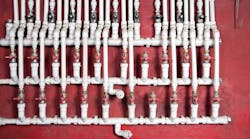This article was updated May 31, 2023. It was originally published March 23, 2000.
Technological advances are pushing the pressure, flow and temperature requirements for fluid and pneumatic pipes and tubing to new heights every day. That’s partly because leaks that were once considered merely nuisances are now classified fugitive emissions and hazardous spills that can shut down plants, making tubing and pipe reliability a high priority. Tubing and pipe both carry fluids in industrial applications, but tubing has several advantages over pipe, according to industry experts.
First off, tube fittings have metal-to-metal seals designed not to leak even under rugged operating conditions. When technicians tighten fitting nuts on metal tubing, it cold-swages ferrules onto the tubing, making a durable, water-tight seal. For threaded-pipe connections, on the other hand, technicians need heavy equipment to cut threads and pipe dope or TFE tape to minimize leaks. In addition, tubing’s greater flexibility leads to fewer connections, so fewer potential leak points and lower costs.
Second, tubing can generally be installed faster than pipe. It is cut to length and deburred, and then fittings are simply tightened onto a nut. Some tube-fitting connections can be checked to ensure they are correctly installed before starting up the system.
Installing a 1-in. tube system takes about 12 min./connection. Compare that to 1-in. Schedule-40 pipe, which takes an hour to cut, prep, align and weld each connection. Screwed pipe fittings are installed faster, but they still take an average of 48 min. to connect and align. And the cost of skilled welders and pipefitters needed to install pipes makes tubing a financially wise choice.
If welding is the only option, however, tubing and an orbital welder still outperforms pipe. Orbital welders are typically quicker and simpler than manual pipe welding because fittings are designed specifically for tubing.
Tubing also cuts installed costs. It’s nearly always less expensive to use tubing than pipe. Tube fittings might cost more than similarly configured pipe components, but in the long run, tubing saves money by reducing downtime, plus it’s simpler to assemble and disassemble.
When adjustments are needed, tubing is flexible and can be easily repositioned. This makes it possible to completely align tubing networks before the final hookup, which is especially beneficial when working with “field-routed” systems. Modifying installed tubing only requires a hacksaw, wrenches and a few new parts. And tube connections have better leak-tight integrity than pipe connections, so they can be reassembled easily and reliably.
Most fluid-handling systems are regularly tweaked and modified on a regular basis, so quick disassembly is important. In tubing systems, users can replace an elbow with a tee in a matter of minutes, and most hardware can be reused. Disassembling threaded pipe, on the other hand, is labor-intensive because each component must be handled individually and sequentially. And welded pipe systems can only be disassembled by cutting, which is a lengthy process.
Tubing supports high pressures and has, on average, a higher strength-to-weight ratio than pipe. It creates better flow because the smooth internal surfaces reduce flow losses and drag. In addition, the internal diameters of the tubing and fittings are nearly identical, which reduces pressure drops and turbulence.
Tube bending improves fluid-flow characteristics by creating compact systems with smooth directional changes. Conversely, the 45 or 90 deg. elbows in piping networks frequently increase turbulence.
Tubing is readily available in diameters up to 2 in. with a variety of wall thicknesses and materials to meet the toughest applications. It’s important to note that tubing and pipe are sized differently. A 1-in. pipe, for instance, has a 1-in. bore, while a 1-in. tube has an outside diameter of 1 in.
RELATED
A History of Landmark Pumps and Waterworks: ASME Milestones
